 |
 |
|
 |
Commissioner, governor call on employees for budget balancing ideas |
 |
 |
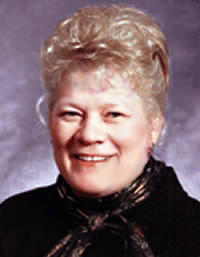 |
Lt. Gov./Commissioner Carol Molnau
|
Mn/DOT employees who have ideas for how to reduce costs for the agency—or how
to generate revenue on Mn/DOT’s assets—now can do so through Mn/DOT’s employees-only
iHUB or Mn/DOT’s Web site.
"I was encouraged that Mn/DOT employees submitted more cost savings ideas
to the Governor's transition team than any other agency. The folks on the front
lines are often the ones with the best ideas on how to get the biggest bang
for the buck," said Lt. Gov./Commissioner Carol Molnau.
Mn/DOT’s Web site and iHUB site debuted this week at the request of Molnau
in order to collect transportation specific ideas for cutting costs. The employees-only
iHUB site also solicits ideas to increase efficiencies in the ways Mn/DOT does
business. These ideas will supplement those generated at the last Commissioner’s
Forum as well as suggestions coming from offices throughout the agency.
Both Mn/DOT’s Web site and iHUB site serve as supplements to the site that
the Department of Finance created at the request of Gov. Tim Pawlenty and the
lieutenant governor. The Finance site collects budget reduction ideas for all
state agencies from the general public and posts suggestions filed there. Finance
staff remove identifying information from the messages before posting them for
the public to read.
Mn/DOT’s Web site and iHUB site also offer anonymity. Suggestions from those
who wish to remain anonymous will remain anonymous, but contributors who want
feedback must supply an address or e-mail address.
Some Mn/DOT employees—and the public—do not have easy access to the Web. Each
site, however, offers a form that a colleague, family member, librarian, etc.,
can print out for those who prefer to send suggestions by mail.
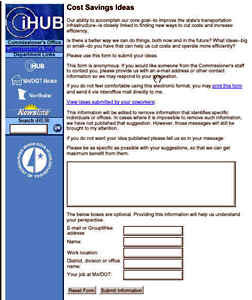 |
Employees with budget-balancing ideas for Mn/DOT can submit those ideas
by visiting this iHUB page.
|
Molnau also e-mailed a memo to employees expressing appreciation for the speed
with which Mn/DOT employees responded to the governor’s and her call for suggestions.
In that memo, she also asked employees, "Is there a better way we can
do things? What ideas—big or small—do you have that can help us cut costs and
operate more efficiently? Change starts with you—and I want you to know that
I am absolutely committed to listening to your thoughts and ideas, now and in
the future."
Another pipeline for budget-balancing ideas (cost savings plus revenue generation)
has developed from Mn/DOT offices that have begun pulling ideas together on
their own initiative. Hundreds of ideas have already gone to a review committee
that will put the ideas into Mn/DOT’s products and services model and make recommendations
to Molnau and to recently appointed Deputy Commissioner Doug Differt.
The members of that review committee are: Scott Peterson, assistant to the
deputy commissioner; Kevin Gray, chief financial officer, Corporate Business
Group; and assistant directors Bruce Biser, Management Operations Group; Dawn
Hagen, Office of Communications and Public Relations; Randy Halvorson, Program
Delivery Group; Rick Kjonaas, State Aid for Local Transportation Group, and
Marthand Nookala, Program Support Group.
Visit these sites to submit a suggestion:
To read the rest of Molnau’s remarks, go to:
Employee memo: http://ihub/commissioner/jan10memo.html.
By Marsha Storck
|
back

|
 |
Renovation of St. Cloud headquarters nears completion |
 |
 |
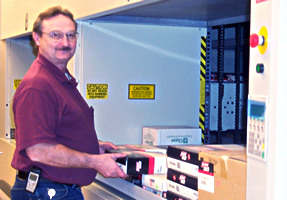 |
Dan Hermann, an auto parts technician, uses the center’s
new automated vertical storage system. The system
stores stock items vertically, saving shelf space
and making stock easier to find. Photo by Mike
Travis
|
When completed this spring, the renovated St. Cloud Maintenance Area headquarters
will provide a vastly improved workspace for the 200 people who work there.
Work on the $11.5 million project began in 2000. Most of the work is nearly
complete.
The structure includes a new wing and a second floor added to the existing
wing. The additions increase available floor space from 90,000 to about 168,000
square feet, said Craig Robinson, maintenance operations engineer.
"We have gone from what was essentially a maintenance building with a
construction office to a full-service facility to better meet customer needs,"
Robinson said.
The renovated building will enable employees to perform their duties more efficiently
and provide better service.
An expanded vehicle maintenance area, for example, will provide an automated,
drive-through wash bay for snowplows, allowing faster turnaround times. Two
more vehicle hoists will improve vehicle maintenance and a new automated storage
system for the inventory center will help employees find needed parts faster.
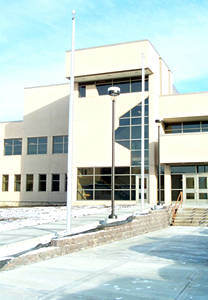 |
Cement panels outline the state’s form over the entrance to the newly
renovated St. Cloud Maintenance Area headquarters building. Photo
by Mike Travis
|
Additional building space will provide room for the new St. Cloud Transportation
Operations Communications Center and other functional areas, including bridge,
the materials lab, right of way, project development, maintenance and the sign
shop. The State Patrol will keep its office space in the building as well.
Staff from most functional areas will move into their new spaces by April,
Robinson said.
Other features of the renovation include an expanded materials lab, a cargo
elevator, an elevator accessible by people who have disabilities, and an energy
management system to control lighting, heating and air conditioning.
The new facility will also include a 250-seat conference center as well as
other smaller meeting rooms. The conference center will be available for all
Mn/DOT staff to take advantage of St. Cloud’s central location, Robinson said.
The building was designed so that a third story could be added if future needs
warrant, he said.
Pre-cast concrete panels in warm earth tones will cover the building’s exterior.
"It should be quite an attractive building," Robinson said.
By Craig Wilkins
|
back

|
 |
Minnesota to host ITS America’s annual conference in May |
 |
 |
The Intelligent Transportation Society of Minnesota will host ITS America’s
2003 annual meeting and exposition May 19-22 at the Minneapolis Convention Center.
Conference participants will explore the theme, "ITS: Real World, Real
Results," in workshops on topics such as traveler information, public safety
and security, and freight mobility. Participants will also have the opportunity
to tour ITS-related facilities and services in the Twin Cities metro area such
as the Regional Traffic Management Center.
The conference will also offer a trip to Rochester to visit the Transportation
Operations and Communications Center and the Mayo Hospital Control Center and
its emergency dispatching system.
In addition, participants may register for pre-conference programs that will
be held May 16-18. Program topics will include project management for advanced
transportation systems, providing travel time information and ways to demonstrate
the value of ITS-related projects to the public.
Marthand Nookala, assistant director, Program Support Group, chairs the event’s
national organizing program committee; Doug Differt, Mn/DOT’s newly appointed
deputy commissioner, leads the ITS Minnesota local arrangements committee.
Hospitality at the airport, technical tours and tours for people accompanying
conference-goers are being arranged by the local planning committee. The ITS
Minnesota Web site at www.itsmn.org lists
local meeting information.
Check out the ITS America Web site at www.itsa.org
for registration and more meeting information.
|
back

|
 |
Railroad names engine house to honor OFRW’s Jim Brandt |
 |
 |
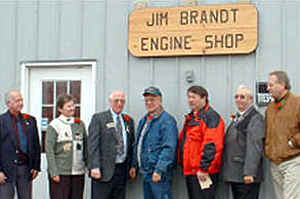 |
Jim Brandt, center, joins the unveiling of the engine house plaque
with members of the Minnesota Valley Regional Rail Authority in Morton.
Photo by Steve Renquist
|
Roundhouse Rodney and Thomas the Tank Engine have nothing on Mn/DOT’s Jim Brandt.
Brandt, a track inspector with the Office of Freight, Railroads and Waterways,
now has a Minnesota Prairie Line engine house named in his honor.
The engine house shelters the rail line's two diesel-electric CP-10 locomotives.
The new railroad’s management placed a handmade wooden plaque bearing Brandt’s
name on its engine house in Morton to recognize his contribution to the $6 million
rail rehabilitation project. The project created the railroad that now provides
service between Hanley Falls and Norwood.
Brandt walked every step of the 94.5-mile route to check the rail bed’s condition
and mark areas that needed repair or replacement.
The service started in October. The Minnesota Prairie Line now offers service
to communities between Hanley Falls and Norwood including Redwood Falls, Morton,
Winthrop, Gaylord and Young America.
Mn/DOT, the Minnesota Valley Regional Railroad Authority and the MINNRAIL Shippers
Association worked together to create the railroad. The new rail service provides
an alternate to shipping commodities such as grain, fertilizer and kaolin clay
by truck.
The rail authority also honored Janelle Collier, a grant analyst with OFRW,
and Al Vogel, OFRW director, for their support of the project.
By Craig Wilkins
|
back

|
 |
National group honors Minnesota transportation system, advocates |
 |
 |
 |
An aerial view shows the rose garden built in connection with the I-35
project in Duluth that helped connect downtown and the lakefront. Photo
by Neil Kveberg
|
Two major pieces of Minnesota’s transportation system, I-35 and the Minneapolis-St.
Paul International Airport, earned honors as the state’s top infrastructure
projects of the 20th Century by the American Road & Transportation Builders
Association. The association also recognized top public officials for their
roles as transportation advocates.
ARTBA officials chose the airport for its role in the state’s economy. The
airport, officials say, serves the state’s need for air travel, promotes trade
and tourism and generates about $100 million in operating revenue. Operated
by the Metropolitan Airports Commission, the airport provides more than 25,000
jobs to area residents.
I-35, ARTBA notes, serves as a key corridor for travelers and as an international
trade route from Laredo, Texas to Duluth. The Minnesota portion of the freeway
earned recognition for innovative solutions such as creating a parkway design
for I-35E in St. Paul and using tunnels that reduce the road’s visual and noise
impacts in Duluth while creating pedestrian-friendly links between the city’s
downtown and the Superior lakefront.
ARTBA also honored three Minnesotans for their contributions to the state’s
and the nation’s transportation systems. Selected were Charles Babcock, a member
of the Minnesota Highway Commission between 1910-17 and the state’s first commissioner
of highways (1917-1932), former U. S. Rep. John Blatnik and current U.S. Rep
James Oberstar.
Babcock’s efforts resulted in the "Babcock Amendment" to the state’s
constitution, which established the state’s trunk highway system and used auto
license fees to finance the system.
Blatnik was honored for work chairing the House Public Works Committee and
his efforts to create the St. Lawrence Seaway and the Port of Duluth.
Oberstar (DFL, 8th District) earned recognition for chairing the House Aviation
Subcommittee, for his work on the House Transportation and Infrastructure Committee
and for supporting the 1991 Intermodal Surface Transportation Efficiency Act
and subsequent acts that provided historic levels of federal support for highway,
mass transit and airport construction programs.
By Craig Wilkins |
back

|
 |
New lighting in Lowry Hill Tunnel promises better vision, reduced costs |
 |
 |
New lighting now being installed in the I-94 Lowry Hill Tunnel near downtown
Minneapolis will create more uniform, safer light for drivers and lower maintenance
costs as well.
Contract crews started the installation on the westbound side of the tunnel
on Sunday. The work will continue each night from 11 p.m. until 5 a.m. the next
morning, requiring closure of two of the tunnel’s three lanes.
Metro Division maintenance managers expect the work on the westbound lanes
to be completed by Jan. 27. When the westbound lanes are done, work will begin
on the tunnel’s eastbound lanes.
Similar work will be done in the nearby Portland Avenue tunnel starting in
late February when the Lowry project is done.
The Lowry Tunnel was built in the 1970s with aluminum fixtures. The new lighting
system, which uses stainless steel components that can withstand the corrosive
effects of the tunnel and factory-sealed housings that resist moisture, dust
and pressure washing, will replace the corroded aluminum ones, said Nicole Rosen,
lighting engineer, Metro Division.
The new system employs a linear light source system instead of single-point
lights sources that will provide more uniform light and reduce glare, she said.
Supplemental lighting at the tunnel’s entrances will help drivers’ eyes adjust
from the light level outside the tunnel to the level inside.
Rosen said energy costs will drop by about two-thirds because the new system
requires only about one-third as many bulbs as the old one.
Drivers’ vision is crucial to safety in the tunnel, which carries an average
of 159,000 vehicles each day.
By Craig Wilkins
To read about this and other items released recently to the news media, visit
the News and Views link on
the Mn/DOT Web site.
|
back

|
 |
|
 |



